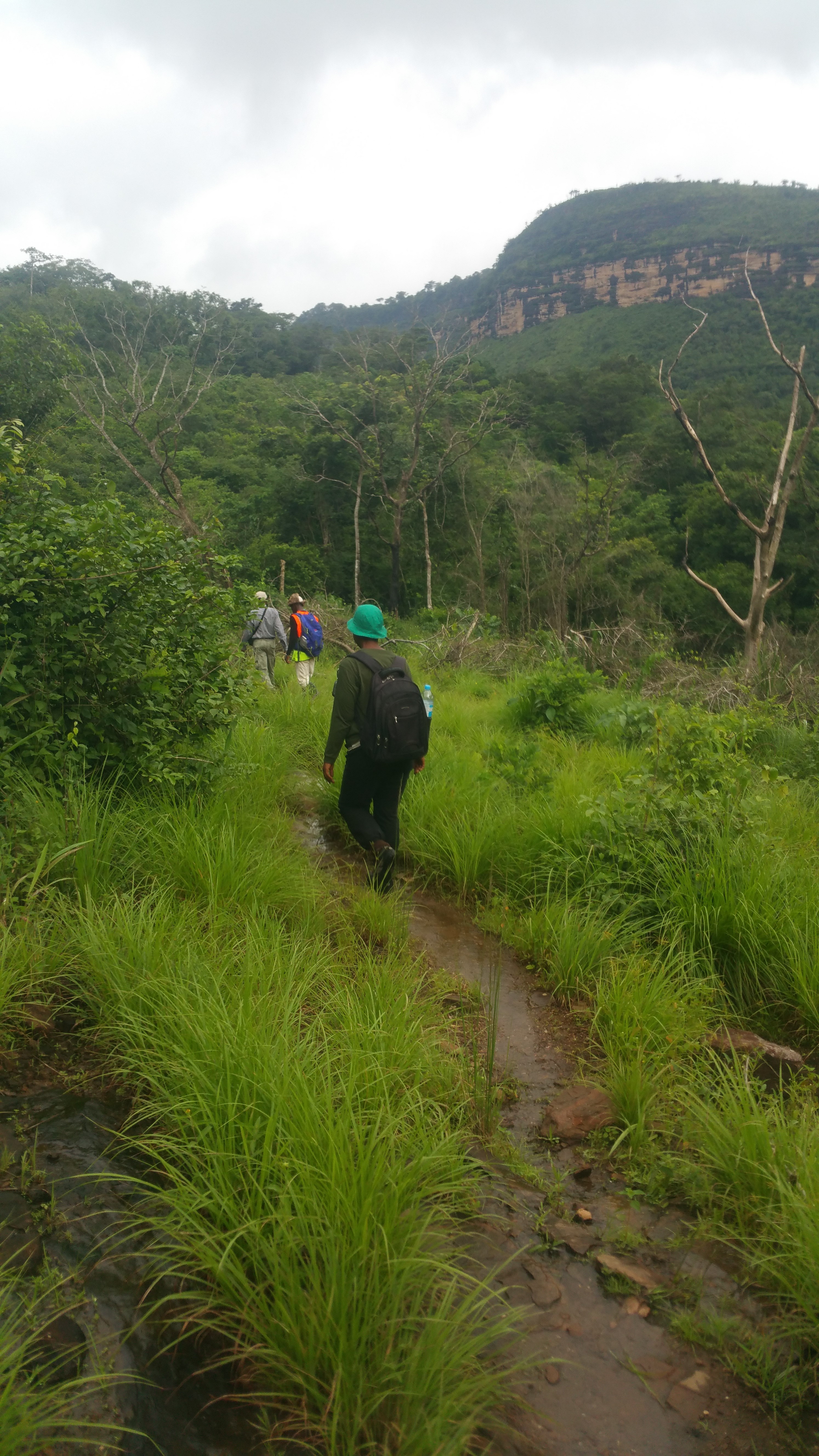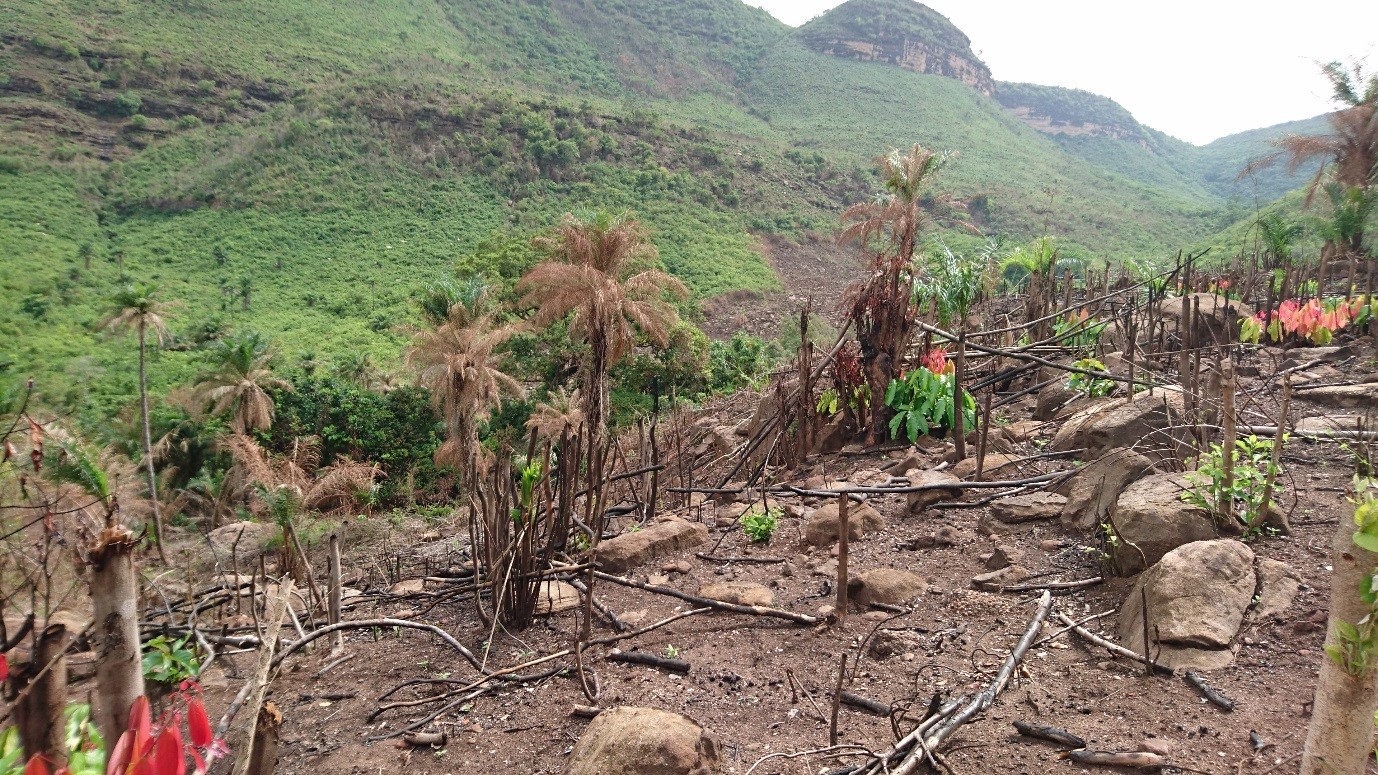
Country: Guinea
Administrative region: Coyah (Prefecture)
Central co-ordinates: 9.72972 N, 13.29 W
Area: 0.1km²
Qualifying IPA Criteria
A(i)Site contains one or more globally threatened species, B(i)Site contains a high number of species within defined habitat or vegetation types, C(iii)Site contains nationally threatened or restricted habitat or vegetation types, AND/OR habitats that have severely declined in extent nationally
IPA assessment rationale
This remnant of lowland forest is a significant habitat for many threatened species and is a very good, possibly the best, representative of the forest patches of the Coyah hills with likely the second highest species diversity so far recorded for this forest type after the Kounounkan Forest in Forécariah Prefecture. The population of Tarenna hutchinsonii is the second largest in Guinée Maritime as well as significant populations of Diospyros feliciana, Baphia heudelotiana (largest population known globally), Stylochaeton pilosus and the newly described Talbotiella cheekii. The forest patches of Coyah are under threat from cultivation and Kakiwondi is a good representation. Although it is a sacred forest, it has been impacted by the slash and burn practice.
Site description
Kakiwondi near the village of Tomboya in central hills of Coyah prefecture is a small sacred forest patch protected by the village. This forest is a remnant of the lowland forest that would have covered this area in the past, and is recognised as one of the national threatened vegetation types. The area is on the side of the Wélé Wélé river valley and quite rocky. The dominant tree, Guibourtia copallifera, gives its name to forest – Kaki – from the Susu language). The area is small, only 100m2, but significant given the pressures of cultivation in surrounding area.


Botanical significance
Kakiwondi is one of the last refuges for some of the rare lowland forest species in the Guinee Maritime region. The region’s second largest population of Tarenna hutchinsonii, and significant populations of Diospyros feliciana, Baphia heudelotiana and Stylochaeton pilosus and the newly described Talbotiella cheekii are all found in this small forest patch. Of several small remnants of lowland forest in the Coyah hills, is it one of the richest in threatened species. It is likely that additional species will be found in future surveys.
Habitat and geology
Small lowland forest patch on the side of a sandstone hill with exposed rocks and boulders of dolerite. It is part of the same Ordovician sandstone ridge that goes northeast through Kindia, up to Pita in the Fouta Djallon. The forest patch is partly sloped and partly plateau with the Wélé Wélé River adjacent.
Conservation issues
Nearby cultivation of land on the slopes using slash and burn clearance methods has led to fire invading the forest patch. Some plants of Tarenna hutchinsonii were lost in 2016. The path through the forest is used to reach neighbouring villages of Kaporo, Yataraya and Saliya by foot; currently this does not seem to have a detrimental effect.
Site assessor(s)
Charlotte Couch, Royal Botanic Gardens Kew
Martin Cheek, Royal Botanic Gardens Kew
Denise Molmou, Herbier National de Guinee/ Simfer
Xander van der Burgt, Royal Botanic Gardens, Kew
IPA criterion A species
| Species | Qualifying sub-criterion | ≥ 1% of global population | ≥ 5% of national population | 1 of 5 best sites nationally | Entire global population | Socio-economically important | Abundance at site |
|---|---|---|---|---|---|---|---|
| Diospyros feliciana Letouzey & F.White | A(i) |  |
 |
 |
 |
 |
Scarce |
| Cryptosepalum tetraphyllum (Hook.f.) Benth. | A(i) |  |
 |
 |
 |
 |
Scarce |
| Tessmannia baikieaoides Hutch. & Dalziel | A(i) |  |
 |
 |
 |
 |
Scarce |
| Baphia heudelotiana Baill. | A(i) |  |
 |
 |
 |
 |
Common |
| Keetia susu Cheek | A(i) |  |
 |
 |
 |
 |
Frequent |
| Talbotiella cheekii Burgt | A(i) |  |
 |
 |
 |
 |
Abundant |
| Apodiscus chevalieri Hutch. | A(i) |  |
 |
 |
 |
 |
Scarce |
| Tarenna hutchinsonii Bremek. | A(i) |  |
 |
 |
 |
 |
Scarce |
| Stylochaeton pilosus Bogner | A(i) |  |
 |
 |
 |
 |
Scarce |
| Guibourtia copallifera Benn. | A(i) |  |
 |
 |
 |
 |
Frequent |
| Homalium smythei Hutch. & Dalziel | A(i) |  |
 |
 |
 |
 |
Occasional |
Diospyros feliciana Letouzey & F.White





Cryptosepalum tetraphyllum (Hook.f.) Benth.





Tessmannia baikieaoides Hutch. & Dalziel





Baphia heudelotiana Baill.





Keetia susu Cheek





Talbotiella cheekii Burgt





Apodiscus chevalieri Hutch.





Tarenna hutchinsonii Bremek.





Stylochaeton pilosus Bogner





Guibourtia copallifera Benn.





Homalium smythei Hutch. & Dalziel





IPA criterion C qualifying habitats
| Habitat | Qualifying sub-criterion | ≥ 5% of national resource | ≥ 10% of national resource | 1 of 5 best sites nationally | Areal coverage at site |
|---|---|---|---|---|---|
| West African Lowland Evergreen Forest | C(iii) |  |
 |
 |
West African Lowland Evergreen Forest


General site habitats
| General site habitat | Percent coverage | Importance |
|---|---|---|
| Forest - Subtropical/Tropical Moist Lowland Forest | 100 | Major |
Forest - Subtropical/Tropical Moist Lowland Forest
Land use types
| Land use type | Percent coverage | Importance |
|---|---|---|
| Nature conservation | 100 | Unknown |
Nature conservation
Threats
| Threat | Severity | Timing |
|---|---|---|
| Agriculture & aquaculture - Annual & perennial non-timber crops - Shifting agriculture | High | Ongoing - increasing |
Agriculture & aquaculture - Annual & perennial non-timber crops - Shifting agriculture
Protected areas
| Protected area name | Protected area type | Relationship with IPA | Areal overlap |
|---|---|---|---|
| Kakiwondi | Community conservation area | protected/conservation area matches IPA |  |
Kakiwondi

Management type
| Management type | Description | Year started | Year finished |
|---|---|---|---|
| No management plan in place |  |
 |
No management plan in place


Bibliography
Flore (Angiospermes) de la République de Guinée.
Threatened plants species of Guinea-Conakry: A preliminary checklist
Peerj Preprints
IUCN Red List
Rapport de terrain du projet Darwin initiative dans la zone de Kindia et Coyah.
Rapport de terrain du projet Darwin initiative dans la zone de Coyah (Dec 2016 - Jan 2107)
Rapport de terrain Darwin zone de Coyah
Recommended citation
Charlotte Couch, Martin Cheek, Denise Molmou, Xander van der Burgt (2024) Tropical Important Plant Areas Explorer: Kakiwondi Forest Patch (Guinea). https://tipas.kew.org/site/kakiwondi-forest-patch/ (Accessed on 27/07/2024)


